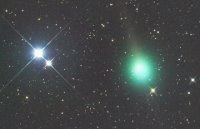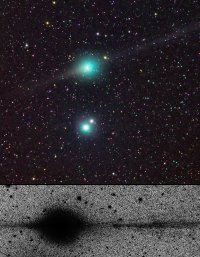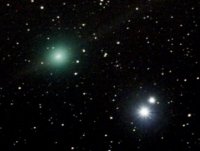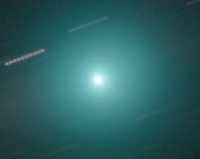
| Summary: Following its close encounter with Earth on Feb. 24th, Comet Lulin (C/2007 N3) is moving away and slowly dimming. [full story] [ephemeris] [3D orbit] [finder charts: Jan.11-Feb.20, Feb.20-Mar.21] |
| Go to Page 1 | 2 | 3 | 4 | 5 | 6 | You are viewing Page 7 | Go to Page 8 | 9 | 10 | 11 | 12 | 13 | 14 | 15 | 16 | 17 | 18 | 19 |
|
FIRST REPORTS OF NAKED-EYE VISIBILITY: Comet Lulin is now visible to the naked eye from dark-sky sites. "This morning, Feb 6th, I noticed a faint smudge above Zubenelgenubi," reports Jeff Barton from the Comanche Springs Astronomy Campus in West Texas. "I then trained my 9x63 binoculars on the fuzzy patch. Yep, nailed it! I was thrilled to finally bag Comet Lulin without optical aid." Another naked-eye sighting report comes from Martin McKenna of Maghera, Northern Ireland: "I went out for a look at Comet Lulin this morning, Feb. 6th, before dawn with my telescope and binoculars. The Moon was very low, so I stood within the shadow of my house and tried to see the comet without optical aid. Using averted vision, I was able to glimpse the comet perhaps a dozen times! It looked like a large grey patch of light very close to Zubenelgenubi. The sight gave me a warm glow on such a frigid frosty night."
more images: from Rob Stinson of Perth, Australia; from Bill Gucfa of Rehoboth, Massachusetts; from James Champagne of Baton Rouge, Louisiana; from Martin Wagner of Sonnenbuehl-Genkingen, Germany; from Guilherme Grassmann of Americana, São Paulo, Brasil; from Catalin M. Timosca of Turda, Romania; |




